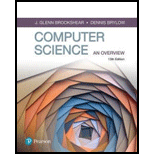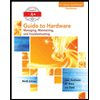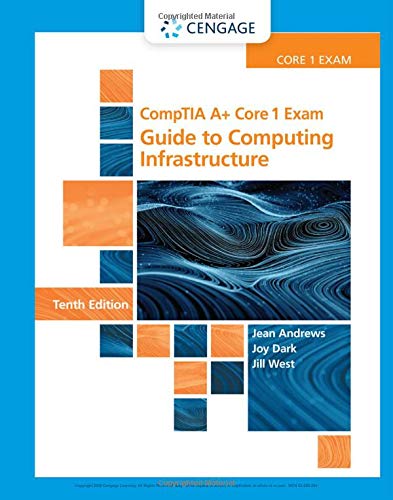
Computer Science: An Overview (13th Edition) (What's New in Computer Science)
13th Edition
ISBN: 9780134875460
Author: Glenn Brookshear, Dennis Brylow
Publisher: PEARSON
expand_more
expand_more
format_list_bulleted
Question
Chapter 2.4, Problem 2QE
Program Plan Intro
AND operation:
This is a Boolean operation in which 0 represents the false value and 1 represents the true value. It produces true output when both inputs are true.
In this operation, if both inputs are false
Expert Solution & Answer
Want to see the full answer?
Check out a sample textbook solution
Students have asked these similar questions
reminder it an exercice not a grading work
GETTING STARTED
Open the file SC_EX19_EOM2-1_FirstLastNamexlsx, available for download from the SAM website.
Save the file as SC_EX19_EOM2-1_FirstLastNamexlsx by changing the “1” to a “2”.
If you do not see the .xlsx file extension in the Save As dialog box, do not type it. The program will add the file extension for you automatically.
With the file SC_EX19_EOM2-1_FirstLastNamexlsx still open, ensure that your first and last name is displayed in cell B6 of the Documentation sheet.
If cell B6 does not display your name, delete the file and download a new copy from the SAM website.
Brad Kauffman is the senior director of projects for Rivera Engineering in Miami, Florida. The company performs engineering projects for public utilities and energy companies. Brad has started to create an Excel workbook to track estimated and actual hours and billing amounts for each project. He asks you to format the workbook to make the…
Need help completing this algorithm here in coding! 2
Whats wrong the pseudocode here??
Chapter 2 Solutions
Computer Science: An Overview (13th Edition) (What's New in Computer Science)
Ch. 2.1 - What sequence of events do you think would be...Ch. 2.1 - What information must the CPU supply to the main...Ch. 2.1 - Prob. 3QECh. 2.2 - Prob. 1QECh. 2.2 - In the text, JUMP instructions were expressed by...Ch. 2.2 - Is the instruction If 0 equals 0, then jump to...Ch. 2.2 - Write the example program in Figure 2.7 in actual...Ch. 2.2 - The following are instructions written in Vole...Ch. 2.2 - What is the difference between the instructions...Ch. 2.2 - Here are some instructions in English. Translate...
Ch. 2.3 - Prob. 1QECh. 2.3 - Suppose the Vole memory cells at addresses 0xB0 to...Ch. 2.3 - Suppose the Vole memory cells at addresses 0xA4 to...Ch. 2.3 - Suppose the Vole memory cells at addresses 0xF0 to...Ch. 2.4 - Prob. 1QECh. 2.4 - Prob. 2QECh. 2.4 - Prob. 3QECh. 2.4 - a. Suppose you XOR the first 2 bits of a string of...Ch. 2.4 - Prob. 5QECh. 2.4 - Prob. 6QECh. 2.4 - Prob. 7QECh. 2.4 - Prob. 8QECh. 2.4 - Prob. 9QECh. 2.4 - Prob. 10QECh. 2.4 - Using Vole machine language (Appendix C), write a...Ch. 2.4 - Prob. 12QECh. 2.5 - Prob. 1QECh. 2.5 - Prob. 2QECh. 2.5 - Prob. 3QECh. 2.6 - The hypotenuse example script truncates the sides...Ch. 2.6 - Prob. 2QECh. 2.6 - The Python built-in function str () will convert a...Ch. 2.6 - Use the Python built-in bin () to write a script...Ch. 2.6 - Prob. 6QECh. 2.7 - Referring back to Questions 3 of Section 2.3, if...Ch. 2.7 - Prob. 2QECh. 2.7 - Suppose there were two central processing units...Ch. 2 - a. In what way are general-purpose registers and...Ch. 2 - Answer the following questions in Vole machine...Ch. 2 - Prob. 3CRPCh. 2 - What is the value of the program counter in the...Ch. 2 - Prob. 5CRPCh. 2 - Prob. 6CRPCh. 2 - Prob. 7CRPCh. 2 - Suppose a machine language is designed with an...Ch. 2 - Translate the following instructions from English...Ch. 2 - Rewrite the program in Figure 2.7 assuming that...Ch. 2 - Classify each of the following Vole instructions...Ch. 2 - Prob. 12CRPCh. 2 - Prob. 13CRPCh. 2 - Suppose the memory cells at addresses 0x00 through...Ch. 2 - Suppose the memory cells at addresses 0x00 through...Ch. 2 - Suppose the memory cells at addresses 0x00 through...Ch. 2 - Suppose the memory cells at addresses 0x00 through...Ch. 2 - Prob. 18CRPCh. 2 - If the Vole executes an instruction every...Ch. 2 - Prob. 20CRPCh. 2 - Prob. 21CRPCh. 2 - Prob. 22CRPCh. 2 - Prob. 23CRPCh. 2 - Write a program in Vole to compute the sum of...Ch. 2 - Prob. 26CRPCh. 2 - Prob. 27CRPCh. 2 - Suppose the following program, written in Vole, is...Ch. 2 - Summarize the steps involved when the Vole...Ch. 2 - Summarize the steps involved when the Vole...Ch. 2 - Summarize the steps involved when the Vole...Ch. 2 - Suppose the registers 0x4 and 0x5 in the Vole...Ch. 2 - Prob. 33CRPCh. 2 - Prob. 34CRPCh. 2 - Prob. 35CRPCh. 2 - Prob. 36CRPCh. 2 - Prob. 37CRPCh. 2 - Prob. 38CRPCh. 2 - Prob. 39CRPCh. 2 - Prob. 40CRPCh. 2 - Prob. 41CRPCh. 2 - Prob. 42CRPCh. 2 - a. What single instruction in the Vole machine...Ch. 2 - Write a Vole program that reverses the contents of...Ch. 2 - Write a Vole program that subtracts the value...Ch. 2 - Prob. 46CRPCh. 2 - Suppose a person is typing forty words per minute...Ch. 2 - Prob. 48CRPCh. 2 - Suppose the Vole communicates with a printer using...Ch. 2 - Write a Vole program that places 0s in all the...Ch. 2 - Prob. 51CRPCh. 2 - Prob. 52CRPCh. 2 - Suppose you are given 32 processors, each capable...Ch. 2 - Prob. 54CRPCh. 2 - Prob. 55CRPCh. 2 - Describe how the average of a collection of...Ch. 2 - Write and test a Python script that reads in a...Ch. 2 - Write and test a Python script that reads in a...Ch. 2 - Prob. 59CRPCh. 2 - Suppose a computer manufacturer develops a new...Ch. 2 - Prob. 2SICh. 2 - Prob. 3SICh. 2 - Prob. 4SICh. 2 - Suppose a manufacturer produces a computer chip...Ch. 2 - Prob. 6SICh. 2 - Prob. 7SICh. 2 - Prob. 8SI
Knowledge Booster
Similar questions
- Help! how do I fix my python coding question for this? (my code also provided)arrow_forwardNeed help with coding in this in python!arrow_forwardIn the diagram, there is a green arrow pointing from Input C (complete data) to Transformer Encoder S_B, which I don’t understand. The teacher model is trained on full data, but S_B should instead receive missing data—this arrow should not point there. Please verify and recreate the diagram to fix this issue. Additionally, the newly created diagram should meet the same clarity standards as the second diagram (Proposed MSCATN). Finally provide the output image of the diagram in image format .arrow_forward
- Please provide me with the output image of both of them . below are the diagrams code make sure to update the code and mentionned clearly each section also the digram should be clearly describe like in the attached image. please do not provide the same answer like in other question . I repost this question because it does not satisfy the requirment I need in terms of clarifty the output of both code are not very well details I have two diagram : first diagram code graph LR subgraph Teacher Model (Pretrained) Input_Teacher[Input C (Complete Data)] --> Teacher_Encoder[Transformer Encoder T] Teacher_Encoder --> Teacher_Prediction[Teacher Prediction y_T] Teacher_Encoder --> Teacher_Features[Internal Features F_T] end subgraph Student_A_Model[Student Model A (Handles Missing Values)] Input_Student_A[Input M (Data with Missing Values)] --> Student_A_Encoder[Transformer Encoder E_A] Student_A_Encoder --> Student_A_Prediction[Student A Prediction y_A] Student_A_Encoder…arrow_forwardWhy I need ?arrow_forwardHere are two diagrams. Make them very explicit, similar to Example Diagram 3 (the Architecture of MSCTNN). graph LR subgraph Teacher_Model_B [Teacher Model (Pretrained)] Input_Teacher_B[Input C (Complete Data)] --> Teacher_Encoder_B[Transformer Encoder T] Teacher_Encoder_B --> Teacher_Prediction_B[Teacher Prediction y_T] Teacher_Encoder_B --> Teacher_Features_B[Internal Features F_T] end subgraph Student_B_Model [Student Model B (Handles Missing Labels)] Input_Student_B[Input C (Complete Data)] --> Student_B_Encoder[Transformer Encoder E_B] Student_B_Encoder --> Student_B_Prediction[Student B Prediction y_B] end subgraph Knowledge_Distillation_B [Knowledge Distillation (Student B)] Teacher_Prediction_B -- Logits Distillation Loss (L_logits_B) --> Total_Loss_B Teacher_Features_B -- Feature Alignment Loss (L_feature_B) --> Total_Loss_B Partial_Labels_B[Partial Labels y_p] -- Prediction Loss (L_pred_B) --> Total_Loss_B Total_Loss_B -- Backpropagation -->…arrow_forward
- Please provide me with the output image of both of them . below are the diagrams code I have two diagram : first diagram code graph LR subgraph Teacher Model (Pretrained) Input_Teacher[Input C (Complete Data)] --> Teacher_Encoder[Transformer Encoder T] Teacher_Encoder --> Teacher_Prediction[Teacher Prediction y_T] Teacher_Encoder --> Teacher_Features[Internal Features F_T] end subgraph Student_A_Model[Student Model A (Handles Missing Values)] Input_Student_A[Input M (Data with Missing Values)] --> Student_A_Encoder[Transformer Encoder E_A] Student_A_Encoder --> Student_A_Prediction[Student A Prediction y_A] Student_A_Encoder --> Student_A_Features[Student A Features F_A] end subgraph Knowledge_Distillation_A [Knowledge Distillation (Student A)] Teacher_Prediction -- Logits Distillation Loss (L_logits_A) --> Total_Loss_A Teacher_Features -- Feature Alignment Loss (L_feature_A) --> Total_Loss_A Ground_Truth_A[Ground Truth y_gt] -- Prediction Loss (L_pred_A)…arrow_forwardI'm reposting my question again please make sure to avoid any copy paste from the previous answer because those answer did not satisfy or responded to the need that's why I'm asking again The knowledge distillation part is not very clear in the diagram. Please create two new diagrams by separating the two student models: First Diagram (Student A - Missing Values): Clearly illustrate the student training process. Show how knowledge distillation happens between the teacher and Student A. Explain what the teacher teaches Student A (e.g., handling missing values) and how this teaching occurs (e.g., through logits, features, or attention). Second Diagram (Student B - Missing Labels): Similarly, detail the training process for Student B. Clarify how knowledge distillation works between the teacher and Student B. Specify what the teacher teaches Student B (e.g., dealing with missing labels) and how the knowledge is transferred. Since these are two distinct challenges…arrow_forwardThe knowledge distillation part is not very clear in the diagram. Please create two new diagrams by separating the two student models: First Diagram (Student A - Missing Values): Clearly illustrate the student training process. Show how knowledge distillation happens between the teacher and Student A. Explain what the teacher teaches Student A (e.g., handling missing values) and how this teaching occurs (e.g., through logits, features, or attention). Second Diagram (Student B - Missing Labels): Similarly, detail the training process for Student B. Clarify how knowledge distillation works between the teacher and Student B. Specify what the teacher teaches Student B (e.g., dealing with missing labels) and how the knowledge is transferred. Since these are two distinct challenges (missing values vs. missing labels), they should not be combined in the same diagram. Instead, create two separate diagrams for clarity. For reference, I will attach a second image…arrow_forward
arrow_back_ios
SEE MORE QUESTIONS
arrow_forward_ios
Recommended textbooks for you
 Systems ArchitectureComputer ScienceISBN:9781305080195Author:Stephen D. BurdPublisher:Cengage Learning
Systems ArchitectureComputer ScienceISBN:9781305080195Author:Stephen D. BurdPublisher:Cengage Learning A+ Guide to Hardware (Standalone Book) (MindTap C...Computer ScienceISBN:9781305266452Author:Jean AndrewsPublisher:Cengage Learning
A+ Guide to Hardware (Standalone Book) (MindTap C...Computer ScienceISBN:9781305266452Author:Jean AndrewsPublisher:Cengage Learning A+ Guide To It Technical SupportComputer ScienceISBN:9780357108291Author:ANDREWS, Jean.Publisher:Cengage,
A+ Guide To It Technical SupportComputer ScienceISBN:9780357108291Author:ANDREWS, Jean.Publisher:Cengage, C++ for Engineers and ScientistsComputer ScienceISBN:9781133187844Author:Bronson, Gary J.Publisher:Course Technology Ptr
C++ for Engineers and ScientistsComputer ScienceISBN:9781133187844Author:Bronson, Gary J.Publisher:Course Technology Ptr Comptia A+ Core 1 Exam: Guide To Computing Infras...Computer ScienceISBN:9780357108376Author:Jean Andrews, Joy Dark, Jill WestPublisher:Cengage Learning
Comptia A+ Core 1 Exam: Guide To Computing Infras...Computer ScienceISBN:9780357108376Author:Jean Andrews, Joy Dark, Jill WestPublisher:Cengage Learning EBK JAVA PROGRAMMINGComputer ScienceISBN:9781337671385Author:FARRELLPublisher:CENGAGE LEARNING - CONSIGNMENT
EBK JAVA PROGRAMMINGComputer ScienceISBN:9781337671385Author:FARRELLPublisher:CENGAGE LEARNING - CONSIGNMENT

Systems Architecture
Computer Science
ISBN:9781305080195
Author:Stephen D. Burd
Publisher:Cengage Learning

A+ Guide to Hardware (Standalone Book) (MindTap C...
Computer Science
ISBN:9781305266452
Author:Jean Andrews
Publisher:Cengage Learning

A+ Guide To It Technical Support
Computer Science
ISBN:9780357108291
Author:ANDREWS, Jean.
Publisher:Cengage,

C++ for Engineers and Scientists
Computer Science
ISBN:9781133187844
Author:Bronson, Gary J.
Publisher:Course Technology Ptr

Comptia A+ Core 1 Exam: Guide To Computing Infras...
Computer Science
ISBN:9780357108376
Author:Jean Andrews, Joy Dark, Jill West
Publisher:Cengage Learning

EBK JAVA PROGRAMMING
Computer Science
ISBN:9781337671385
Author:FARRELL
Publisher:CENGAGE LEARNING - CONSIGNMENT